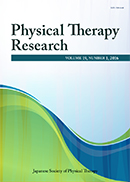Volume 19, Issue 1
Displaying 1-10 of 10 articles from this issue
- |<
- <
- 1
- >
- >|
Scientific Research Article (Original Article)
-
2016 Volume 19 Issue 1 Pages 1-7
Published: December 20, 2016
Released on J-STAGE: December 20, 2016
Download PDF (366K) -
2016 Volume 19 Issue 1 Pages 8-12
Published: December 20, 2016
Released on J-STAGE: December 20, 2016
Download PDF (70K) -
2016 Volume 19 Issue 1 Pages 13-23
Published: December 20, 2016
Released on J-STAGE: December 20, 2016
Download PDF (3085K) -
2016 Volume 19 Issue 1 Pages 24-31
Published: December 20, 2016
Released on J-STAGE: December 20, 2016
Download PDF (83K) -
2016 Volume 19 Issue 1 Pages 32-38
Published: December 20, 2016
Released on J-STAGE: December 20, 2016
Download PDF (95K) -
2016 Volume 19 Issue 1 Pages 39-49
Published: December 20, 2016
Released on J-STAGE: December 20, 2016
Download PDF (661K) -
2016 Volume 19 Issue 1 Pages 50-57
Published: December 20, 2016
Released on J-STAGE: December 20, 2016
Download PDF (417K)
Survey Report
-
2016 Volume 19 Issue 1 Pages 58-66
Published: December 20, 2016
Released on J-STAGE: December 20, 2016
Download PDF (543K)
Physical Therapy Japan Vol. 42 (2015) ABSTRACTS
-
2016 Volume 19 Issue 1 Pages 67-109
Published: December 20, 2016
Released on J-STAGE: December 20, 2016
Download PDF (1319K)
Editorial Board
-
2016 Volume 19 Issue 1 Pages e1
Published: December 20, 2016
Released on J-STAGE: December 20, 2016
Download PDF (524K)
- |<
- <
- 1
- >
- >|
